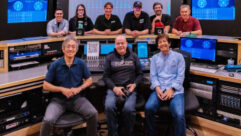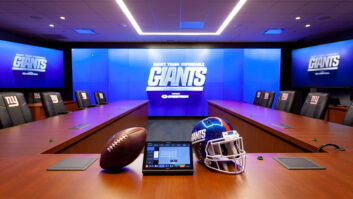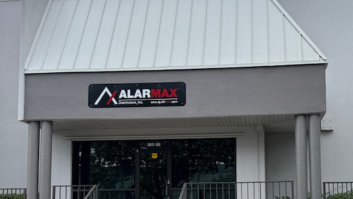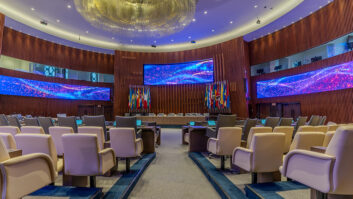
Sony SRP-X700P
Oct 1, 2005 12:00 PM,
By John McJunkin
Computer-controlled digital powered mixer consolidates seven pieces of gear in a single box.
Simplicity. It’s nice to have everything you need wrapped up in a tidy package. Sony’s SRP-X700P digital powered mixer ($2,795) provides simplicity and completeness. It combines the functionality of seven distinct devices in a single package: an RGB switcher, a video switcher, a wireless tuner base unit, an audio mixer, a power amplifier, a feedback reducer, and an EQ. Having all these devices in a single unit delivers on the promise of simplicity of operation. Above all else, this mixer’s real power lies in its extensive computer-control functionality. It ships with SRP-X700P Manager software that enables control over the unit’s powerful signal processing and routing. Let me tell you what I discovered when I recently spent some time with one of these units.
One of the first things that struck me with this unit was I/O — lots and lots of I/O. And that’s the point; this box ties together all the audio and video sources you have in your boardroom, lecture room, or place of worship. There are four XLR connectors dedicated to microphone inputs (Mic Inputs 1 to 4) and two more that can be used for line-level input as well (Mic 5 and 6/Line 1 and 2.) All these have 48V phantom power switchable per channel. There is also a stereo pair of RCA inputs (Line 3). The unit’s Line 4 input is quite clever in that it allows front-panel switching between as many as six discrete video/audio inputs. The first three inputs (4A, 4B, 4C) accept composite video or S-Video. Inputs 4D and 4E accept RGB video and decoded 5.1 audio. The final input, 4F, takes RGB and stereo audio. I easily connected several devices of different types and got both audio and video signals into the mixer.
There are a total of 10 line-level outputs available, the first two of which are represented by balanced XLR connectors. There are also six RCA line-level, user-configurable line outputs and two more RCA outputs that are dedicated to “record out” functionality. I like this feature because, for instance, it makes playback of any part of a board meeting easy. There are also two speaker terminals that can drive a simple pair of speakers, as in my test drive, or numerous speakers in a 70V configuration. The video output (as selected from the 4A to 4F inputs via the front panel) is represented by S-Video, 5BNC, and composite video output terminals, accommodating virtually any configuration.
Aside from the two antenna connections for the optional internal wireless receivers, the remaining connections contend with control issues. First, there are “control S” outputs for control of Sony DVD, VCR, CD, or MD products. There is also an RS-232C terminal and control S I/O pair for projector control. A bi-directional remote parallel terminal enables not only remote control of external equipment, but also control of the SRP-X700P from a remote location. Another RS-232C terminal (not associated with projector control) is also intended to enable control of the mixer from a remote location. Finally, a USB terminal connects the mixer to a computer. And that brings us to the meat and potatoes.
This unit is useful by itself, but most of its power is accessible only via computer control. In the not-so-distant past, I would have deemed that a shortcoming, but it’s almost 2006, and any systems integrator not using computers extensively will be left in the dust. Computer control unlocks so much power with this unit that even the most computer-resistant professional would be strongly compelled to dig right in.

One other thing. I don’t mean to gloss over the front-panel controls, but they are unbelievably simple. Third-grader-could-handle-it simple. There are only eight faders, two master level knobs, six switches for switching between the Line 4 inputs, four switches to change scenes, and two slots for wireless receivers. That’s it — simple, elegant, and easily handled by even an untrained professional.
The SRP-X700P Manager software has a primary window. At its bottom are seven tabs: Block, Input, Routing, Output, Remote, Group Fader, and Scene. They are self-explanatory and when I used the software, I easily navigated where I wanted to go. The Block page gave a broad overview of inputs, outputs, routing, and signal processing. I could type in names for each of the inputs and outputs, up to eight characters each, especially nice for customization in an install. Also on the Block page, LED-type metering showed input and output levels throughout the system.
The Input page is laid out just like a mixer — virtual faders, metering, and EQ and dynamics sections. Each input channel has a trim control; a low-cut filter; a three-band parametric EQ (two-band on the line-level inputs); an automated feedback-reduction feature; soft, mid, or hard compression; a gain limiter; and a mute switch. The EQs are powerful (and sound great), with graphic representation of the curve. The Routing page is self-explanatory, and a matrix enables the routing of any input to any output. That same screen has enable and setup buttons for an automatic mixer function, which features compression, gating, and an “only one” function, which allows only one mic to be heard at any given moment.
The Output page, like the Input page, resembles a mixer — faders, metering, and nice graphical EQ controls. Each output can also be delayed by as much as 150.8ms in 2.9ms increments. I love being able to correct for phase in a larger room. Each output also has a limiter to help protect speakers. Even the record output levels can be adjusted via the software from the Output page. Another major output feature (and another that I really love) is 10-band, fully parametric EQ on each channel. Very powerful. There’s actually also an 11th band, intended normally as an LPF for use on a subwoofer channel.
The Remote page defines specifics regarding the control of external units by the mixer (including shuttle controls for playback devices) or control of the mixer remotely. The Group Fader page enables setup and naming of fader groups. And finally, the Scene page allows the storage of up to 20 scenes or snapshots of the system. A simpler user control panel is also available if deep parametric control is not necessary.
I am truly impressed with this package. It is simple to set up and use. The I/O and operation are self-explanatory. Many of the unit’s most powerful functions are available only when controlling it from a computer, which some could consider a negative. I submit that using a computer is very much worthwhile. This scheme clearly decreased this unit’s cost by eliminating an expensive hardware GUI. You already have that GUI in the form of a computer, so you save money by avoiding duplication. One minor complaint — an Ethernet interface would be much appreciated. USB is fine for now, but future revisions should add Ethernet capability to expand and extend computer control. Otherwise, the cost of this unit is well justified by the extensive mixing, routing, signal processing, and simple operation. I would even say that it’s quite inexpensive considering the feature set. I strongly recommend the SRP-X700P for any serious contractor or integrator.
PRODUCT SUMMARY
Company: Sony Electronics
www.sony.com/proaudio
Product: Sony SRP-X700P
Pros: Powerful signal processing, routing, and mixing capabilities in one package.
Cons: No Ethernet interface.
Applications: Ideal for boardrooms, lecture rooms, and houses of worship.
Price: $2,795
SPECIFICATIONS
Composite Video/S-Video
Color system NTSC/PAL/SECAM
Frequency Response 50Hz to 10MHz
Level 1 Vp-p (75Ω)
Component Video
Color system NTSC/PAL/SECAM
Frequency Response 50Hz to 150MHz
Level Y 1 Vp-p (75Ω)
R-Y 0.7 Vp-p (75Ω)
B-Y 0.7 Vp-p (75Ω)
RGB
Frequency Response 50Hz to 150MHz
Resolution 1280×1024 pixels
60Hz (SXGA)
Level G 0.7 Vp-p (75Ω)
B 0.7 Vp-p (75Ω)
R 0.7 Vp-p (75Ω)
SYNC/HD, VD 1-5V (47kΩ)
Audio
Frequency Response, Line in – Line out 20Hz to 20kHz
THD, Line in – Line out Less than 0.01 percent (1kHz)
S/N Ratio, Line in – Line out More than 94dB (IHF A)
Crosstalk, Line in – Line out Less than -85dB (1kHz)
Power Requirements 120/220/230VAC, 50/60Hz
Power Consumption 150W
Operating Temperature +32°F to +104°F (0°C to +40°C)
Storage Temperature -4°F to +140°F (-20°C to +60°C)
Dimensions 19″×5.25″×13.875″, 3RU
Weight approx. 28lbs. 11oz.
John McJunkinis the principal of Avalon Audio Services in Phoenix. He provides recording and sound reinforcement services, consults in the development of a variety of systems, and is involved in audio education with the Conservatory of Recording Arts & Sciences.









